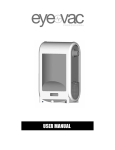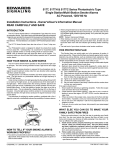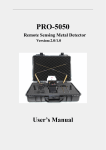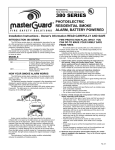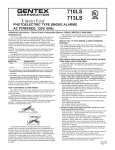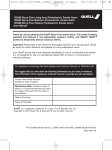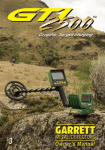Download User`s Manual
Transcript
CONVOY SECURITY WIRELESS OPERATION © Thank you for purchasing the Wireless Radio Link DC Powered Smoke Alarm. Wireless Radio Link Technology is the easy, cost-effective way to provide your family with whole-home safety. All Wireless Radio Link Alarms communicate with each other without wires or connectors. When one Alarm sounds, they all sound. This provides your family with an earlier warning of potential danger, and gives you more time to react. The communication distance (range) between any two Wireless Radio Link Alarms is typically 100 feet (30 meters) inside of a home. Some features of a home, such as the number of floors, number/size of rooms, furniture and types of building materials used may reduce the range of the Alarms. Examples include: suspended ceilings, ductwork, large metallic appliances (refrigerators) and metal studs. A feature of Wireless Radio Link Alarms is that they operate as a mesh network. All Alarms will repeat any alarm signal that is received to all other Wireless Radio Link Alarms. Interference from structural conditions can be overcome by adding additional Alarms to route the wireless signal around obstructions. USER’S MANUAL WIRELESS RADIO LINK PHOTOELECTRIC SMOKE AND FIRE ALARM MODEL DG331 Wireless Radio Link Battery Operated Photoelectric Smoke Alarm IMPORTANT! • The range and proper operation of any wireless device will vary depending on its surroundings. It is very important that each Alarm is tested individually before and after installation to make sure that all Alarms respond properly. • The Wireless Radio Link Alarms are not to be used outdoors or to transmit between buildings. The Alarms will not communicate properly under these conditions. • Metal objects and metallic wallpaper may interfere with signals from wireless Alarms. Alarms should be tested after changes to your home such as remodeling, moving furniture, and with metal doors opened and closed. Your Wireless Radio Link Smoke Alarm will automatically communicate potential fires with all other Wireless Radio Link Smoke Alarms. IMPORTANT! PLEASE READ CAREFULLY AND SAVE. This user’s manual contains important information about your Smoke Alarm’s operation. If you are installing this Smoke Alarm for use by others, you must leave this manual—or a copy of it—with the end user. For your convenience, write down the following information. If you call our Consumer Hotline, these are the first questions you will be asked. Smoke Alarm Model Number (located on back of detector): IMPORTANT! READ ALL INSTRUCTIONS BEFORE INSTALLATION AND KEEP THIS MANUAL NEAR THE ALARM FOR FUTURE REFERENCE. CONTENTS OF THIS MANUAL 1 -- RECOMMENDED LOCATIONS FOR SMOKE ALARMS 2 -- LOCATIONS TO AVOID FOR SMOKE ALARMS 3 -- INSTALLATION INSTRUCTIONS 4 -- OPERATION AND TESTING 5 -- NUISANCE ALARMS 6 -- MAINTENANCE 7 -- LIMITATIONS OF SMOKE ALARMS 8 -- GOOD SAFETY HABITS 9 -- NFPA PROTECTION STANDARD 72, SECTION 2-2.1 10 -- SERVICE AND WARRANTY Date Code (located on back of detector). Manufacturer recommends replacing this alarm five years from the date code: Date of Purchase: Where Purchased: Do not try to repair the smoke alarm yourself. Refer to the instructions in Section 10 for service. DG331Manual Page 1 of 5 © 2010 CONVOY SECURITY 1. RECOMMENDED LOCATIONS FOR ALARMS • Locate the first alarm in the immediate area of the bedrooms. Try to protect the exit path as the bedrooms are usually farthest from the exit. If more than one sleeping area exists, locate additional alarms in each sleeping area. • Locate additional alarms to protect any stairway as stairways act like chimneys for smoke and heat. • Locate at least one alarm on every floor level. • Locate an alarm in every bedroom. • Locate an alarm in every room where electrical appliances are operated(i.e. portable heaters or humidifiers). • Locate an alarm in every room where someone sleeps with the door closed. The closed door may prevent the alarm from waking the sleeper. • Smoke, heat, and combustion products rise to the ceiling and spread horizontally. Mounting the smoke alarm on the ceiling in the center of the room places it closest to all points in the room. Ceiling mounting is preferred in ordinary residential construction. • For mobile home installation, select locations carefully to avoid thermal barriers that may form at the ceiling. For more details, see MOBILE HOME INSTALLATION below. • When mounting an alarm on the ceiling, locate it at a minimum of 4” (10 cm) from the side wall (see Figure 1). • When mounting the alarm on the wall, it is best to use an inside wall with the top edge of the alarm at a minimum of 4” (10 cm) and a maximum of 12” (30.5 cm) below the ceiling, (see Figure 1). • Put smoke alarms at both ends of a bedroom hallway or large room if the hallway or room is more than 30 feet (9.1 m) long. • Install Smoke Alarms on sloped, peaked or cathedral ceilings at or within 3ft (0.9m) of the highest point (measured horizontally). NFPA 72 states: “Smoke alarms in rooms with ceiling slopes greater than 1 foot in 8 feet (.3m in 2.4 m) horizontally shall be located on the high side of the room.” NFPA 72 states: “A row of detectors shall be spaced and located within 3 ft (0.9m) of the peak of the ceiling measured horizontally” (see Figure 3). FIGURE 2 FIGURE 3 MOBILE HOME INSTALLATION Modern mobile homes have been designed and built to be energy efficient. Install smoke alarms as recommended above, refer to RECOMMENDED LOCATIONS and Figure 1. In older mobile homes that are not well insulated compared to present standards, extreme heat or cold can be transferred from the outside to the inside through poorly insulated walls and roof. This may create a thermal barrier that can prevent the smoke from reaching an alarm mounted on the ceiling. In such units, install the smoke alarm on an inside wall with the top edge of the alarm at a minimum of 4” (10 cm) and a maximum of 12” (30.5 cm) below the ceiling (see Figure 1). If you are not sure about the insulation in your mobile home, or if you notice that the outer walls and ceiling are either hot or cold, install the alarm on an inside wall. For minimum protection, install at least one alarm close to the bedrooms. For additional protection, see SINGLE FLOOR PLAN in Figure 2. FIGURE 1 DG331Manual Page 2 of 5 © 2010 CONVOY SECURITY sound 3 beeps, pause, 3 beeps.) WARNING: TEST YOUR SMOKE ALARM OPERATION AFTER R.V. OR MOBILE HOME VEHICLE HAS BEEN IN STORAGE, BEFORE EACH TRIP AND AT LEAST ONCE A WEEK DURING USE. 8. Attach the Smoke Alarm to the mounting bracket. Line up the guides on the alarm’s base with the guides on the mounting bracket. When guides are lined up, turn the base clockwise (right) until it snaps into place. 9. Test the Smoke Alarm. See “Weekly Testing.” 2. LOCATIONS TO AVOID FOR ALARMS In general, alarms should not be located: • In the garage. Products of combustion are present when you start your automobile. • Less than 4” (10cm) from the peak of an “A” frame type ceiling. • In an area where the temperature may fall below 40ºF or rise above 100ºF. • In dusty areas. Dust particles may cause nuisance alarms or failure to alarm. • In very humid areas or near a bathroom. Moisture or steam can cause nuisance alarms. • In insect-infested areas. • Smoke alarms should not be installed within 3 ft (0.9m) of the following: The door to a kitchen, the door to a bathroom containing a tub or shower, forced air supply ducts used for heating or cooling, ceiling paddle or whole house ventilating fans, or other high air flow areas. • Kitchens. Normal cooking may cause nuisance alarms. If a kitchen alarm is desired, it should have an alarm silence feature or be a photoelectric type. • Near fluorescent lights, amateur radios, electrical equipment or other devices known to transmit in the RF band. Electronic “noise” may cause nuisance alarms. • Near large metal surfaces and bundles of wire. FIGURE4 3. INSTALLATION INSTRUCTIONS 1. Hold base firmly and twist the mounting bracket counterclockwise to separate it from the base. 2. Hold the mounting bracket against the ceiling (or wall) so the vertical mounting slot is aligned in the 12 o’clock position and trace around the inside of the mounting slots (vertical and horizontal mounting). 3. Put the unit where it won’t get covered with dust when you drill the mounting holes. 4. Using a 3/16” (5 mm) drill bit, drill a hole through the center of the oval outlines you traced. 5. Insert the plastic screw anchors (in the plastic bag with screws) into the holes. Tap the screw anchors gently with a hammer, if necessary, until they are flush with the ceiling or wall. (see Figure 4). 6. Attach the mounting bracket to the ceiling or wall. 7. Install the battery (included). Open the battery drawer. Match the terminals on the end of the battery with the terminals on the unit. Match “+” to “+” and “-” to “-.” Push the battery in until it snaps in securely and cannot be shaken loose. If the battery is not snapped in completely, the unit cannot receive battery power. (see Figure 5) FIGURE5 4. OPERATION AND TESTING OPERATION: The smoke alarm is operating once a fresh battery is installed and testing is complete. When products of combustion are sensed, the unit sounds a loud 85db pulsating alarm until the air is cleared. FLASHING LED LIGHT: This smoke alarm is equipped with a flashing red indicator light. The light will flash every 30 40 seconds to indicate that the smoke alarm is receiving power SMOKE SENSING CHAMBER OPERATION: This alarm will “chirp” if any of the components in the smoke sensing chamber fail. This chirp will occur between the flashes of the red LED indicator light. (If the chirp occurs at the same time as the red LED flash, see Section 6 for low battery information.) SELF TESTING: Test by pushing the test button on the cover. This unit’s red LED will flashes and the unit would “chirp” three times, if the electronic circuitry, horn, and battery are working. If no alarm sounds, the unit has defective batteries or other failure. You can also test the NOTE: After you install the battery, the power indicator light may flash. (If the unit alarms, the light will blink rapidly, and the horn will repeatedly DG331Manual Page 3 of 5 © 2010 CONVOY SECURITY alarm by blowing smoke into it. have sensing limitations. Ionization type alarms offer a broad range of fire sensing capabilities but are better at detecting fast flaming fires than slow smoldering fires. Photoelectric alarms sense smoldering fires better than flaming fires. Home fires develop in different ways and are often unpredictable. Neither type of alarm (photoelectric or ionization) is always best, and a given alarm may not always provide warning of a fire. • A battery powered alarm must have a battery of the specified type, in good condition and installed properly. • A.C. powered alarms will not operate if the A.C. power has been cut off, such as by an electrical fire or an open fuse. • Smoke alarms must be tested regularly to make sure the batteries and the alarm circuits are in good operating condition. • Smoke alarms cannot provide an alarm if smoke does not reach the alarm. Therefore, smoke alarms may not sense fires starting in chimneys, walls, on roofs, on the other side of a closed door or on a different floor. • If the alarm is located outside the bedroom or on a different floor, it may not wake up a sound sleeper. • The use of alcohol or drugs may also impair one’s ability to hear the smoke alarm. For maximum protection, a smoke alarm should be installed in each sleeping area on every level of a home. • Although smoke alarms can help save lives by providing an early warning of a fire, they are not a substitute for an insurance policy. Home owners and renters should have adequate insurance to protect their lives and property. INTERCONNECT RADIO TESTING: Test by pushing the test button on the cover and holding it down for a minimum of 6 “chirp”. This alarm red LED would light steady. and the sound will change to steady from “chirp”. And then the alarm will send radio alarm signal to other radio link alarms. TEST THE ALARM WEEKLY TO ENSURE PROPER OPERATION. Erratic or low sound coming from your alarm may indicate a defective alarm, and it should be returned for service. 5. NUISANCE ALARMS Smoke alarms are designed to minimize nuisance alarms. Cigarette smoke will not normally set off the alarm, unless the smoke is blown directly into the alarm. Combustion particles from cooking may set off the alarm if the alarm is located close to the cooking area. Large quantities of combustible particles are generated from spills or when broiling. Using the fan on a range hood which vents to the outside (non-recirculating type) will also help remove these combustible products from the kitchen. If the alarm does sound, check for fires first. If a fire is discovered, get out and call the fire department. If no fire is present, check to see if one of the reasons listed in Section 2 may have caused the alarm. 6. MAINTENANCE BATTERY REPLACEMENT To replace the battery, remove the alarm from the mounting bracket by rotating the alarm counterclockwise. The Smoke Alarm is powered by a 9V carbon zinc battery (alkaline and lithium batteries may also be used). A fresh battery should last for one year under normal operating conditions. This alarm has a low battery monitor circuit which will cause the alarm to “chirp” approximately every 30 - 40 seconds for a minimum of seven (7) days, accompanied by the red LED flash, when the battery gets low. Replace the battery when this condition occurs. 8. GOOD SAFETY HABITS DEVELOP AND PRACTICE A PLAN OF ESCAPE • Make a floor plan indicating all doors and windows and at least two (2) escape routes from each room. Second story windows may need a rope or chain ladder. • Have a family meeting and discuss your escape plan, showing everyone what to do in case of fire. • Determine a place outside your home where you all can meet if a fire occurs. • Familiarize everyone with the sound of the smoke alarm and train them to leave your home when they hear it. • Practice a fire drill at least every six months. Practice allows you to test your plan before an emergency. You may not be able to reach your children. It is important they know what to do. CLEANING YOUR ALARM To clean your alarm, remove it from the mounting bracket as outlined in the beginning of this section. You can clean your alarm by using compressed air or your vacuum cleaner hose to blow or suck air through the openings around the perimeter of the alarm. The outside of the alarm can be wiped with a damp cloth. After cleaning, reinstall your alarm. Test your alarm by using the test button. WHAT TO DO WHEN THE ALARM SOUNDS • Leave immediately by your escape plan. Every second counts, so don’t waste time getting dressed or picking up valuables. • In leaving, don’t open any inside door without first feeling its surface. If hot, or if you see smoke seeping through cracks, don’t open that door! Instead, use your alternate exit. If the inside of the door is cool, place your shoulder against it, open it slightly and be ready to slam it shut if heat and smoke rush in. • Stay close to the floor if the air is smoky. Breathe 7. LIMITATIONS OF SMOKE ALARMS WARNING: PLEASE THOROUGHLY READ CAREFULLY AND Smoke alarms are devices that can provide early warning of possible fires at a reasonable cost; however, alarms DG331Manual Page 4 of 5 © 2010 CONVOY SECURITY shallowly through a cloth, wet if possible. • Once outside, go to your selected meeting place and make sure everyone is there. • Call the fire department from your neighbor’s home - not from yours! • Don’t return to your home until the fire officials say that it is all right to do so. 10. SERVICE AND WARRANTY If after reviewing this manual you feel that your smoke alarm is defective in any way, do not tamper with the unit. Return it for servicing to: Convoy Security. (See Warranty for in-warranty returns) FIVE YEAR LIMITED WARRANTY There are situations where a smoke alarm may not be effective to protect against fire as stated in the NFPA Standard 72. For instance: Convoy Security warrants to the original purchaser that the enclosed smoke alarm (but not the battery) will be free from defects in material and workmanship or design under normal use and service for a period of five years from the date of purchase. The obligation of Convoy Security under this warranty is limited to repairing or replacing the smoke alarm or any part which we find to be defective in material, workmanship or design, free of charge to the customer, upon sending the smoke alarm with proof of date of purchase, postage and return postage prepaid, to Warranty Service Department, Convoy Security. a) smoking in bed b) leaving children home alone c) cleaning with flammable liquids, such as gasoline Further information on fire safety can be obtained in a pamphlet titled “IN A FIRE SECONDS COUNT” published by the NFPA, Batterymarch Park, Quincy, MA 02269 This warranty shall not apply to the smoke alarm if it has been damaged, modified, abused or altered after the date of purchase or if it fails to operate due to improper maintenance or inadequate A.C. or D.C. electrical power. THE LIABILITY OF CONVOY SECURITY OR ANY OF ITS PARENT OR SUBSIDIARY CORPORATIONS ARISING FROM THE SALE OF THIS SMOKE ALARM OR UNDER THE TERMS OF THIS LIMITED WARRANTY SHALL NOT IN ANY CASE EXCEED THE COST OF REPLACEMENT OF SMOKE ALARM AND, IN NO CASE, SHALL CONVOY SECURITY OR ANY OF ITS PARENT OR SUBSIDIARY CORPORATIONS BE LIABLE FOR CONSEQUENTIAL LOSS OR DAMAGES RESULTING FROM THE FAILURE OF THE SMOKE ALARM OR FOR BREACH OF THIS OR ANY OTHER WARRANTY, EXPRESS OR IMPLIED, EVEN IF THE LOSS OR DAMAGE IS CAUSED BY THE COMPANY’S NEGLIGENCE OR FAULT. 9. NFPA REQUIRED PROTECTION The National Fire Protection Association’s Standard 72 reads as follows: 2-2.1.1.1 Smoke alarms shall be installed outside each separate sleeping area in the immediate vicinity of the bedrooms and on each additional story of the family living unit, including basements and excluding crawl spaces and unfinished attics. In new construction, a smoke alarm shall be installed in each sleeping room. A-2.5.2.1 Smoke Detection - Are More Smoke Detectors Desirable? The required number of smoke alarms might not provide reliable early warning protection for those areas separated by a door from the areas protected by the required smoke alarms. For this reason, it is recommended that the householder consider the use of additional smoke alarms for those areas for increased protection. The additional areas include the basement, bedrooms, dining room, furnace room, utility room, and hallways not protected by the required smoke alarms. The installation of the smoke alarms in the kitchen, attic (finished or unfinished), or garage is normally not recommended, as these locations occasionally experience conditions that can result in improper operation. Since some states do not allow limitations on the duration of an implied warranty or do not allow the exclusion or limitation of incidental or consequential damages, the above limitations or exclusions may not apply to you. While this warranty gives you specific legal rights, you may also have other rights which vary from state to state. Also, Convoy Security makes no warranty, express or implied, written or oral, including that of merchantability or fitness for any particular purpose, with respect to the battery. The above warranty may not be altered except in writing signed by both parties hereto. This equipment should be installed in accordance with the National Fire Protection Association’s Standard 72 (NFPA, Batterymarch Park, Quincy, MA 02269). NOTIFY YOUR LOCAL FIRE DEPARTMENT AND INSURANCE COMPANY OF YOUR SMOKE ALARM INSTALLATION. DG331Manual Page 5 of 5 © 2010 CONVOY SECURITY





